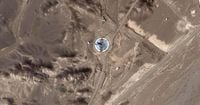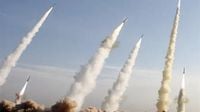Satellite photos reviewed by the Associated Press have ignited a storm of speculation and unease about Iran’s missile ambitions, after evidence surfaced of an undeclared launch at the Imam Khomeini Spaceport in Semnan province on September 18, 2025. While Iranian officials have remained conspicuously silent, signs on the ground—and in the skies—have painted a picture that is hard to ignore.
The launch site, located about 230 kilometers southeast of Tehran, is no stranger to activity. In the weeks leading up to the suspected test, the circular pad had been freshly painted in the red, white, and green of the Iranian flag. But by September 18, satellite images showed the pad marred by significant scorch marks, the telltale aftermath of a powerful rocket launch. This visual evidence, reported by Associated Press and corroborated by analysts at Planet Labs PBC, matched the patterns seen after previous launches from the site.
On the evening of September 18, social media in Semnan province buzzed with photos of a contrail streaking across the sunset sky. The dramatic image only fueled rumors, as neither Iranian officials nor state media acknowledged the event or its cause. The silence was deafening, especially given the tense political climate and the looming threat of United Nations sanctions set to be reimposed over Tehran’s nuclear program the following weekend.
Into this information vacuum stepped Mohsen Zanganeh, a member of Iran’s parliament. Appearing on state television, Zanganeh made a bold, unverified claim: Iran had successfully tested an intercontinental ballistic missile (ICBM). “The night before last we tested one of the country’s most advanced missiles, which until now had not, so to speak, been trialed—and that test was successful,” he declared, as reported by Associated Press. “In other words, I mean to say that even under these conditions we are conducting a security test of an intercontinental-range missile.”
The implications of such a test are enormous. ICBMs typically have ranges greater than 5,500 kilometers, far outstripping Iran’s publicly declared 2,000-kilometer cap—a limit set by Supreme Leader Ayatollah Ali Khamenei, which already covers Israel and U.S. bases in the Middle East. If Zanganeh’s claim is true, Iran would have the ability to strike targets across Europe and possibly beyond. However, the lawmaker provided no evidence, and Iranian MPs are known for occasional exaggeration. As Associated Press noted, “Iranian parliament members have made exaggerated claims in the past.”
Despite the absence of official confirmation, independent analysts have weighed in. Fabian Hinz, a research fellow at the International Institute for Strategic Studies, told Associated Press that the scorch marks at the site suggested the use of a solid-fuel missile. Solid-fuel technology is prized for its mobility and rapid launch capability—attributes that make such missiles harder to detect and neutralize. The specific burn pattern, Hinz said, was similar to those left by Zuljanah, Iran’s three-stage rocket designed for satellite launches but with potential military applications.
The timing of the test is no coincidence. Just months earlier, in June 2025, Israel launched a 12-day campaign that targeted and destroyed several Iranian missile sites. That conflict, according to Behnam Ben Taleblu of the Foundation for Defense of Democracies, was a wake-up call for Tehran. “Israel’s successes in the 12-day war against Iran’s missile attacks reinforced for Tehran the importance of developing more ballistic missiles and qualitatively better versions of them,” Taleblu told Associated Press. “Consider this part of Tehran’s efforts to build back better, and as quickly as possible.”
But what exactly was launched? That remains a mystery. Despite the contrail and scorched earth, there has been no confirmation of a new Iranian satellite in orbit—something that would normally follow a successful space launch. U.S. space trackers have not recorded any new payloads, suggesting either a failed satellite launch or a test with purely military intent. As one missile expert put it, quoted by Associated Press: “With Iran, it’s always hard to know what is a coincidence and what is a pattern.”
The ambiguity surrounding the launch feeds into broader international concerns about Iran’s intentions. While U.S. intelligence agencies currently assess that Iran is not actively pursuing a nuclear bomb, the country has enriched uranium to 60 percent—dangerously close to weapons-grade. The combination of advanced solid-fuel missile technology and near-weapons-grade uranium is a worrying prospect for the West, especially as both sides brace for a new round of sanctions and diplomatic pressure.
Iran has long maintained that its nuclear program is peaceful and that its missile development is defensive in nature. However, the dual-use nature of rockets like Zuljanah blurs the line between civilian and military applications. The U.S. government and its allies have repeatedly voiced concerns that such technology could be repurposed for long-range missile development, potentially giving Iran the capability to deliver nuclear warheads far beyond its region.
Analysts say the timing of the launch—just days before the United Nations was expected to reinstate sanctions—may have been a calculated move by Tehran to send a message of defiance. “If, as is increasingly being alleged, the test was of a space-launch vehicle, it represents a desire by Tehran to potentially threaten targets outside the Middle East, like the European continent and even the American homeland,” Taleblu explained to Associated Press.
Despite the political theater, several questions remain unanswered. Was the launch truly an ICBM, as Zanganeh claimed? Or was it a failed satellite launch, a technical mishap, or even a warning shot meant to signal resolve? Without official acknowledgment or hard evidence, the world is left to read between the lines of scorched earth and silent skies.
For now, all eyes remain on the Imam Khomeini Spaceport, where a single night’s activity has reignited old fears and raised new stakes in the ongoing standoff between Iran and the West. As the dust settles and the scorch marks fade, the uncertainty lingers—reminding everyone that, in Iran’s missile program, little is ever as it seems.


